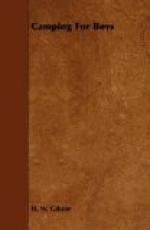The “whale” is made of a big log of wood with a rough-shaped head and tail to represent a whale. Two boats are used, each manned by the boys of one tent—the leader acting as captain, a boy as bowman or harpooner, the others as oarsmen. Each boat belongs to a different harbor, the two harbors being some distance apart. The umpire takes the “whale” and lets it loose about half-way between the two harbors and on a signal the two boats race out to see who can get to the “whale” first. The harpooner who first arrives within range of the “whale” drives his harpoon into it and the boat promptly turns around and tows the “whale” to its harbor. The second boat pursues and when it overtakes the other, also harpoons the “whale,” turns around and endeavors to tow the “whale” to its harbor. In this way the two boats have a tug-of-war and eventually the better boat tows the “whale” and possibly the opposing boat into its harbor.
Shoot-the-Chute
[Illustration: Diagram For “Chute”]
A “Shoot-the-Chute” is great fun and one should be built in every permanent camp and “Swimming Hole.” The one described is by A. D. Murray and has stood the test of several years in a number of camps.
The plan drawn is for a chute 40 feet long, 3 feet wide and 18 feet high. These dimensions can be changed in length and height, but not in width. The chute is built of 7/8-inch matched pine boards, to the same width as sheet zinc, usually 3 feet; the boards being firmly cleated together on the under side by 2 x 6-inch cleats 5 feet apart, throughout the length of the chute. Boards should be screwed to the cleats from the face of the chute with 1-1/2-inch screws, the heads being counter sunk. The several lengths of zinc are soldered into one piece, the joints being on the under side (as shingles on a roof) fastened to the boards with 8-oz. tacks; set in from the edge about 1 inch and about 6 inches apart. The side strips of maple (soft wood will not do on account of the danger of splintering) 2 inches wide and 3 inches high, rounded slightly on upper edge, are placed directly over the edge of the zinc and covering the tacks. Screw the strips firmly to the chute with 2-inch screws from the under side. These ought to be placed not more than 2 feet apart. Probably each will have two or more strips in making a piece of sufficient length. If so, care should be taken to have the pieces joined on a bevel with a slant from outer edge toward bottom of chute so as to leave no edge. The utmost care should be used to have a perfectly smooth surface on the inside of the chute. A pump or bucket is needed at the top of the chute to wet the surface before the swimmer starts his slide. The supports A, B, C, should be firmly braced with 2 x 4-inch timber, D, and lower end of chute should extend over the pier at least 1 foot and not nearer the surface of the water than 3 feet perpendicularly, allowing the swimmer to enter the water as in a dive. The chute can be fastened to the supporting braces through timbers E, F, into maple side strips with a good heavy log screw. A platform 3 feet wide and 4 feet long near the top of chute, and set just waist deep from the top of chute will make starting easy.




